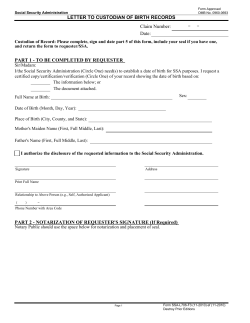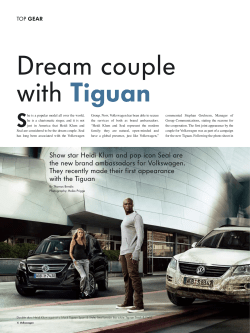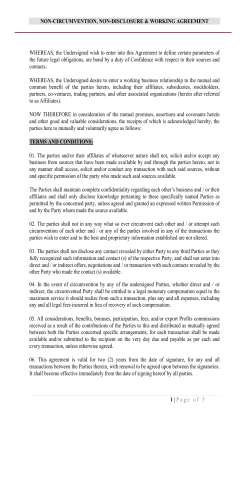
Achieve a Perfect Seal Achieve a Perfect Seal
Achieve a Perfect Seal © Enercon Industries & Selig Group Achieve a Perfect Seal 5 Secrets to Induction Cap Sealing Success © Enercon Industries & Selig Group Achieve a Perfect Seal Today’s Presenters B.J. Radek Selig Group Regional Sales Manager Jeff LaGrange Ryan Schuelke Enercon Industries Enercon Industries Cap Seal Product Manager Vice President Sales Owen Schmidt © Enercon Industries & Selig Group Achieve a Perfect Seal Overview Induction Seal Function Matching your Materials: Product/Liner/Cap Cap Concerns Torque, Geometry, Depth of foil Induction Sealing Principles PHT How to set-up an operating window Test methods for identifying a good seal Troubleshooting Tips from the Pros Questions/Answers © Enercon Industries & Selig Group Achieve a Perfect Seal 5 Secrets to Achieving a Perfect Seal Document Results Optimize Materials & Equipment Heat Pressure Time Operating window TORQUE! © Enercon Industries & Selig Group Achieve a Perfect Seal Induction Seal’s Functionality © Enercon Industries & Selig Group Achieve a Perfect Seal Leak Prevention © Enercon Industries & Selig Group Achieve a Perfect Seal Tamper Evidence | Consumer Confidence © Enercon Industries & Selig Group Achieve a Perfect Seal Preserve Freshness © Enercon Industries & Selig Group Achieve a Perfect Seal Removal Characteristics Peelable - Clean Peel The entire liner peels away cleanly, leaving the container opening clean and clear of residue. Peelable - Tamper Indicating The liner peels away but leaves a residue on the container opening, showing visual evidence of entry. Peelable: Clean Peel Peelable: Tamper Indicating True Weld – Pierceable (Easy Entry) Seal can be easily punctured, torn, or broken with one's finger to open and leaves visible evidence of entry. True Weld - Puncture Resistant The foil must be cut to gain entry, usually with the help of an implement. True Weld: Easy Entry © Enercon Industries & Selig Group True Weld: Puncture Resistant Achieve a Perfect Seal Container - Liner Compatibility Polyethylene (PE) Polypropylene (PP) Polyester (PET) Polyvinyl Chloride (PVC) © Enercon Industries & Selig Group Polystyrene (PS) Glass Achieve a Perfect Seal Filling Method / Product Treatment Cold Fill Hot Fill Flood Fill © Enercon Industries & Selig Group Retort Achieve a Perfect Seal Product Consideration Food Beverage Pharmaceutical Chemical Personal Care Dry Viscous Liquid High Acid Aggressive Ingredient Inert Contents Aggressive Contents (Barrier Layer) © Enercon Industries & Selig Group Achieve a Perfect Seal Types of Induction Seals | One Piece One Piece Foil Seal One Piece Induction (Foil Required) Backing Foil PET Barrier Heat Seal Reseal not critical/cap reseal adequate Food & beverage applications Wide-mouth & dispensing closures © Enercon Industries & Selig Group Induction heat to soften the heat seal surface Adhered to container T.E. capable Barrier properties - foil Achieve a Perfect Seal Types of Induction Seals | One Piece One Piece Backings (closure contact surface) Materials - Board - Foam Backing Bonding Foil Heat Seal - Laminated (0.0055” - 0.0105”) - Extruded (0.015” - 0.040”) Strength for Liner Retention in Closure Even Pressure Upon Sealing FoilSeal™ - 1 Piece © Enercon Industries & Selig Group Achieve a Perfect Seal Types of Induction Seals | Two Piece Two Piece Foil Seal Two Piece Induction (Foil Required) Induction heat to soften the heat seal surface Primary hermetic seal & optional secondary seal (2piece) Adhered to container T.E. capable Barrier properties – foil Backing Temporary Bond Foil PET Barrier Heat Seal Reseal critical/unlined cap reseal poor Barrier (ie - Pharmaceutical & Nutraceutical) Reseal (ie - AgChem & Automotive Fluids) Temporary Bond: Wax Bond - softens during induction and absorbs into pulp Polymer Bond - weak bond separates at initial closure removal © Enercon Industries & Selig Group Achieve a Perfect Seal Types of Induction Seals | Two Piece 2 Piece Two Piece Backings (reseal liner) 2 Piece (LE or E) Facing Temporary Bond Backing Materials Pulp - 0.020” - 0.035” Foam Temporary Bond - Extruded - 0.015” - 0.040” Wax or Polymer Bonded – Temporary - Real Seal Liner Barrier (E, LE) Insulate Closure from Heat Strength for Liner Retention in Closure Even Pressure Upon Sealing Optional Facing: PET (printing) FoilSeal™ - 2 Piece © Enercon Industries & Selig Group Achieve a Perfect Seal Types of Induction Seals | Tabbed Versions Tabbed Versions Backing Wax Bond PET PET Tab Foam Foil Heat Seal One Piece Lift ‘n’ Peel™ PET PET Tab Foam Foil Heat Seal ½ Moon Shaped Tabs Easier to Grip Youth/Advanced Age Dexterity Sight Impaired No Contact with Seal/Product Surface Two Piece Top Tab™ © Enercon Industries & Selig Group Achieve a Perfect Seal Matching the Induction Sealer to the Application © Enercon Industries & Selig Group Achieve a Perfect Seal Matching Equipment Cap Size Foil Size Depth of Foil Line Speed ( BPM, FPM, MPM) Cap/Bottle Geometry Foil Type © Enercon Industries & Selig Group Application Range - Hot Fill - Cold Fill - Room Temperature Achieve a Perfect Seal Cap Styles Continuous Thread Child Resistant Dispensing © Enercon Industries & Selig Group Achieve a Perfect Seal Cap Styles Depth of Foil Big Cap - Small Foil Torque © Enercon Industries & Selig Group Achieve a Perfect Seal Sealer Options © Enercon Industries & Selig Group Achieve a Perfect Seal Sealing Head Options © Enercon Industries & Selig Group Achieve a Perfect Seal Pressure, Heat And Time © Enercon Industries & Selig Group Achieve a Perfect Seal Pressure, Heat and Time Cap Application Torque © Enercon Industries & Selig Group Achieve a Perfect Seal Pressure, Heat and Time Electromagnetic field reacts with foil to generate heat © Enercon Industries & Selig Group Achieve a Perfect Seal Pressure, Heat and Time Conveyor Speed © Enercon Industries & Selig Group Achieve a Perfect Seal Pressure, Heat and Time The Relationship is not linear © Enercon Industries & Selig Group Achieve a Perfect Seal Establishing Your Cap Sealing Operating Window No Seal Partial Seal Good Seal © Enercon Industries & Selig Group Overheated Seal Achieve a Perfect Seal Induction Seal Characteristics © Enercon Industries & Selig Group Achieve a Perfect Seal Operating Window Best Practices 1. 2. 3. 4. System Set up Determine Minimum Sealing Power Determine Maximum Sealing Power Choose & Record Production Set Point © Enercon Industries & Selig Group Achieve a Perfect Seal Set up Controlled and centered bottle path Set Air gap –must be parallel to conveyor END VIEW SIDE VIEW CL HEAD SEALING HEAD GAUGE CONVEYOR Gap Gauge © Enercon Industries & Selig Group Flat Sealing Head Achieve a Perfect Seal Determine your minimum set-point © Enercon Industries & Selig Group Achieve a Perfect Seal Determine your maximum set-point © Enercon Industries & Selig Group Achieve a Perfect Seal Determine your production set-point 58% 65% © Enercon Industries & Selig Group Achieve a Perfect Seal Record Settings Product Cap Size Conveyor speed Power Level © Enercon Industries & Selig Group Achieve a Perfect Seal Record Data Determine at what output % the best seal is achieved. Repeat for all cap/container configurations • • • • • • • Container details Closure details Liner material details Closure application torque Conveyor speed Sealing head air gap Output % © Enercon Industries & Selig Group Achieve a Perfect Seal Recording Data Options Some data can also be recorded on board the sealer © Enercon Industries & Selig Group Achieve a Perfect Seal How to determine if you have a good seal? © Enercon Industries & Selig Group Achieve a Perfect Seal Determining a Good Seal ASTM Guideline – No specific guideline for induction seal integrity – There are guidelines for leak tests Most companies create their own definition of a good seal though various testing methods © Enercon Industries & Selig Group Achieve a Perfect Seal Good Seal Characteristics Good adhesion on the entire circumference Minimum Wrinkling No discoloration indicates proper output level © Enercon Industries & Selig Group Achieve a Perfect Seal Good Seal Characteristics Foam backed liners should have their foam still intact 2 piece liners will show no darkening of the pulpboard © Enercon Industries & Selig Group Achieve a Perfect Seal Determining a Good Seal Vacuum (Wet or Dry) Shipping Vision systems Mechanical pressure Shake, Squeeze or Stand! © Enercon Industries & Selig Group Achieve a Perfect Seal Determining a Good Seal Enercon uses a vacuum leak detector – in conjunction with customer specification When should you test? – Immediate hermetic seal – Seal strength changes over first 24 hours © Enercon Industries & Selig Group Achieve a Perfect Seal Troubleshooting Tips from the Pros © Enercon Industries & Selig Group Achieve a Perfect Seal Troubleshooting A detailed explanation of the issue begins with identifying the problem. First question to ask “Is the problem consistent?” Types of problems - No Seal - Partial Seal - Overheated Seal - Inconsistent Seals © Enercon Industries & Selig Group Achieve a Perfect Seal The #1 Cause for poor seals Torque! Torque! Torque! Inconsistent or insufficient application torque accounts for 80% of all problems. Cap Size (mm) 15 18 20 22 24 28 33 38 43 48 53 Torque (inch/lbs) 6 to 9 7 8 to to 10 12 9 to 14 10 to 16 12 to 18 15 to 25 17 to 26 18 to 27 19 to 30 21 to 36 © Enercon Industries & Selig Group Achieve a Perfect Seal © Enercon Industries & Selig Group Achieve a Perfect Seal No Seal Is the sealer turned on? Was there a liner in the cap? Does all of your current set-up data match your operating window documentation? • What may have changed? –Line speed? –Container Resin? –Liner Material ? Application torque © Enercon Industries & Selig Group Achieve a Perfect Seal Partial Seal Output too low/line speed too high Not centered Low Application torque Cocked cap Cap bottoms out Saddle in land area Ridge in land area © Enercon Industries & Selig Group Achieve a Perfect Seal Under heated seal Output too low/line speed too high Liner material will does not adhere properly Seal that lets go under light pressure to no adhesion On 2 piece liners there may also be a swirling pattern or poor wax absorption © Enercon Industries & Selig Group Achieve a Perfect Seal Overheated seal Output too high Line speed too slow Wrinkling/odor Pulp board discoloration/burning Cocked cap © Enercon Industries & Selig Group Achieve a Perfect Seal Other considerations © Enercon Industries & Selig Group Achieve a Perfect Seal Troubleshooting Closure information – Cap supplier, size and style. – Tracing information. • Lot #, Pallet #, Job or Order #, Roll Serial # • Each box of closures should be traceable to each unique roll of material thru the Roll Serial #. Bottle supplier, material and mold numbers © Enercon Industries & Selig Group Achieve a Perfect Seal Troubleshooting Induction Sealer – Unit Make and Model – Type of sealing head coil. (tunnel, flat, skewed) – Induction settings (power level, air gap) Application info – New or existing application? – Product being filled and filling conditions – Line speed – Application Torque © Enercon Industries & Selig Group Achieve a Perfect Seal 5 Secrets to Achieving a Perfect Seal Document Results Optimize Materials & Equipment Heat Pressure Time Operating window TORQUE! © Enercon Industries & Selig Group Achieve a Perfect Seal Questions & Answers B.J. Radek Selig Group Regional Sales Manager bjradek@seligsealing.com Jeff LaGrange Enercon Industries Cap Seal Product Manager jlagrange@enerconmail.com Selig Group 630-615-7247 Owen Matt www.seligsealing.com Schmidt Rajala © Enercon Industries & Selig Group Ryan Schuelke Enercon Industries Vice President Sales rschuelke@enerconmail.com Enercon Industries 262-255-6070 Bill www.enerconind.com/sealing Zito Achieve a Perfect Seal Thank you © Enercon Industries & Selig Group Achieve a Perfect Seal
© Copyright 2025











